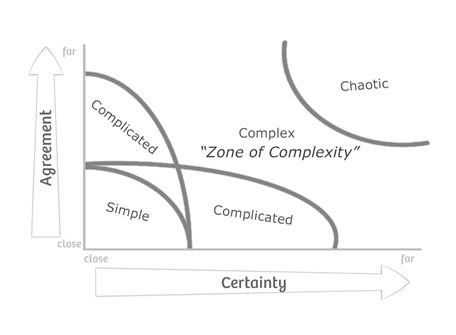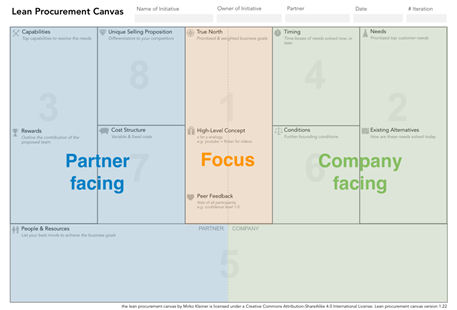Lean-Agile Procurement: Can complex sourcing really be agile?
As customer demand becomes one of the burning platforms for change, the need to be agile is reaching all areas of business. But, if we really want to deliver value early and often, we need to take a systems approach and address any pain points in the organisation that impact our ability to deliver end to end value.
Because of late business alignment and competing customer demands, procurement can become one of those pain points. From identifying business requirements, vendor selection, evaluating RFXs, vendor evaluation, contract development and agreement, this process is often slow and cumbersome.
I've been an agile practitioner for many years, and I started my Lean-Agile Procurement journey in 2019. My first introduction was joining Mirko Kleiner's Lean-Agile Procurement (LAP1) workshop. Yes, procurement can be agile, and it applies the same agile values and principles that I've been inspired by in my journey as an agile coach and facilitator.
"Lean-agile procurement is an agile approach for complex procurements, where collaboration between people is a key success factor." – Mirko Kleiner, Flowdays
The goals of Lean-Agile Procurement are to:
- Reduce preparation efforts and rework
- Reduce time-to-market
- Evaluate partner fit
- Simplify the creation of proposals
- Create an agile contract.
The difference between agile and waterfall is that in a waterfall approach, you assume you know everything upfront and that nothing will change. That is why comprehensive requirements gathering and planning are done upfront. In an agile approach, we know that we can't know everything upfront, and we expect things to change. That is why an iterative and incremental approach with collaboration and short feedback loops is practised.
The Stacey Matrix is a great tool to help us understand the factors that contribute to complexity so we can decide the best actions to take to address them.

Stacey RD. Strategic management and organisational dynamics: the challenge of complexity.
Very simply, there are two dimensions of the matrix and four zones. The first is certainty, and the second is agreement, which relates the what and how. If we know what we need to do and how to do it, then this sits in the simple zone.
The next zone is the complicated zone, where the what and how might have a number of correct solutions. Here the team can usually assess and decide based on good practice and experience.
The sweet spot for agile is in the complex zone because the requirements (the what) are usually not so clear from the start, and they also change a lot. Then the how is also not completely clear upfront. Sometimes teams don't know what problems may arise or how they will tackle them. So, we need quick responses to constantly changing environments.
How does agile help us navigate complexity?
- Cross-functional teams with all the necessary capabilities are formed, ensuring the best approach is taken (because you have the right people involved). It also reduces handovers from team to team as we have all the capabilities within the team.
- Continuous conversations and collaborations foster ongoing discovery and alignment around the what and how.
- Short, iterative working cycles with feedback loops allow for adaptations without costly implications.
- The continuous collaborative learning process reduces risk and uncertainty and improves quality.
- The focus on delivering value to the customer over a long list of wants ensures faster time to market.
Lean-Agile Procurement in action
Last year I was fortunate to work with Mirko Kleiner during an engagement where I was an agile coach to an MNC pharma. They were forming a new portfolio for their Digital Customer Engagement Network that would focus on achieving digital maturity within the organisation at the affiliate level. They needed to leverage and optimise core and common solutions that met patient needs and could be scaled to the enterprise.
Until then, there hadn’t been a unified vision or roadmap that aligned the enterprise programs and portfolios. There were many Digital Customer Engagement initiatives within the organisation, but no overarching, clear strategy for the enterprise, so they needed to find a partner who could:
- Facilitate and co-create a vision with all the key stakeholders which challenged them in their areas for growth
- Support the delivery at scale.
A cross-functional team was formed, which included procurement and other key stakeholders. Led by the Head of Digital Engagements as the Product Owner, they applied a Scrum operating model to work through all the steps that were needed to prepare for the partner evaluation. Using the business case as input, the cross-functional team co-created a Lean Procurement Canvas.

lean-agile-procurement.com/lean-procurement-canvas
The purpose of the Lean Procurement Canvas is to simply communicate the problem and solution on one page, working through key risks, and whether both the company and partner together can achieve the main goals. The canvas aims to answer the questions:
- Are we solving the right problem for our customers with the right solution?
- Do we have the right partner to meet the business needs?
- Do the conditions match?
- Do we have the right fit people?
- Does the partner have potential for the future?
Four vendors were invited to join a virtual two-day big room event. A big room event is where three to four vendors are hosted together in one room with the cross-functional team and business stakeholders to design the solution, define the approach, demo the solution where possible to get feedback and co-create the proposal. This ensures maximum alignment and therefore minimises risks by talking about all the assumptions and addressing questions and challenges. It also creates the space to test the collaboration with the people that will be involved in the delivery, building trust in the prospective partner early on.
Vendors bring their experts and are encouraged to share their ideas and proposals. They can even challenge and question the rationale of the organisation or ideas from their competitors. The aim is to create a culture of openness and learning and also to assess business fit and social fit, which is needed to be successful in the complex space.
"If a vendor doesn't feel comfortable or agree with the values of openness, well, then maybe they're the wrong partner." - Mirko Kleiner, Flowdays
Around 35-40 people from both the business and vendors joined the event. The ‘in-person’ event was replicated virtually by creating collaborative working spaces in Miro and breakout rooms in Google Meet.
The event was opened up with a panel of senior partners from each vendor to inspire everyone with information about the current market developments, industry trends, learnings from other customers, and impact on the organisation. This was followed by virtual breakout groups where the consultants met and led smaller workshops with business participants to collaborate and co-create an approach for an enterprise digital customer engagement vision and roadmap and scaled delivery proposal.
A private google chat group was created so the company participants could share their thoughts on the progress and raise questions and concerns with the prospective partners - this worked well as they started to form their preferences. There was loads of energy, enthusiasm and a willingness to embrace this new approach. It provided transparency into the collaboration process and gave greater visibility to each prospective partner's strengths and weaknesses based on ongoing conversations and presentations throughout the event.
At the end of day one, the cross-functional team had a debrief and unanimously decided to let one vendor go. They felt their level of questions, interactions, ideas, and proposals was average.
On day two, the remaining three vendors continued in the big room event collaborating and refining their ideas and proposals with the business to define the visioning and roadmap approach to form the Digital Customer Engagement Network with a phase one execution plan.
At the close of the event, the cross-functional team was clear on which partner they wanted to move forward with, and surprisingly they chose two partners. One of the large management consulting firms were selected to support the strategic alignment aspect, and a relatively unknown company, new to the organisation but very well-presented, was selected to support the delivery phase as they really impressed the group with their insights and practical approach, they’d bring to support the delivery at scale.
Within a month of the big room event, the contracts were agreed upon, teams formed, and the kick-off workshops for phase one had already begun. Even though there were a lot of participants both from the customer and the partners, the smaller cross-functional team, which included procurement, were empowered to make the decision to proceed and able to reach an agreement on the contracting terms swiftly.
While agile works well in the delivery space, there are proven benefits in procurement. Below are a few of my takeaways on how lean-agile values and principles contributed to the success of the sourcing process:
- Ensuring the cross-functional team (procurement, compliance and key stakeholders) includes people who will do the delivery at the beginning of the process, and everyone who is needed in the chain reduces handovers. This includes the business owner or product owner, who is a core member of the cross-functional team.
- Moving away from transactional interactions to collaborative interactions, the cross-functional team working model created a shared understanding and alignment within the team on what was needed.
- Short, iterative working cycles were practised, working through the same procurement steps up to delivery so that teams are still compliant and can adapt where needed.
- Moving beyond the fixed scope, fixed price contracting so that we allow flexibility in a complex engagement. The continuous conversations about shared risk between the prospective partner and the company created trust and transparency.
- Vendors have a rare opportunity to learn from other vendors. I am sure that the vendor who was let go at the end of day one had a good reflection on what they could have improved as they were able to see the level of conversations and capabilities the other vendors were bringing.
- Focus on the needs and mission, the whys vs the wants and continuously talking about possible adaptations ensures the focus is outcomes driven.
While this engagement is still in the early stages, it is important that for continued success, there is still engaged leadership, continuous collaboration, and alignment. This includes the partner in the cross-functional team, short feedback loops and regular inspect and adapt intervals.
If you’re curious about how your team can speed up the delivery of procurement, our Lean-Agile Procurement training will walk through one of your sourcing challenges so you can see how this approach can be applied in your context.
For more Lean-Agile Procurement success stories, check out the global LAP community: https://www.lean-agile-procurement.com/blog-1/2021/1/30/6-success-stories-agile-in-procurement-just-talk-or-reality
Posted by Nicola Stephens.
Thank you!
Your details have been submitted and we will be in touch.
Thank you!
Your details have been submitted and we will be in touch.